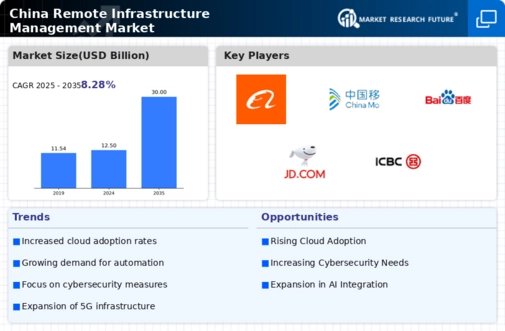Expansion of 5G Technology
The expansion of 5G technology is poised to have a transformative impact on the remote infrastructure-management market in China. With its high-speed connectivity and low latency, 5G enables more efficient management of remote systems. This technological advancement allows for real-time monitoring and control of infrastructure, enhancing operational capabilities. As 5G networks continue to roll out across urban and rural areas, the potential for remote infrastructure management solutions to leverage this technology is substantial. Industry analysts predict that the integration of 5G could lead to a 40% increase in the efficiency of remote management operations, thereby driving market growth.
Rise of Cybersecurity Concerns
In the context of the remote infrastructure-management market, the rise of cybersecurity concerns is a critical driver. As organizations in China increasingly rely on digital infrastructure, the threat of cyberattacks has escalated. This has led to a heightened focus on securing remote management systems. Companies are investing in advanced security measures to protect sensitive data and maintain operational integrity. The market for cybersecurity solutions is projected to grow significantly, with estimates suggesting an increase of over 20% annually. This growing emphasis on cybersecurity is likely to influence the adoption of remote infrastructure management solutions, as businesses seek to ensure robust protection against potential threats.
Growing Demand for Cost Efficiency
the remote infrastructure-management market in China is seeing a surge in demand for cost efficiency. Organizations are increasingly seeking solutions that minimize operational costs while maximizing productivity. This trend is driven by the need to optimize resource allocation and reduce overhead expenses. According to recent data, companies that implement remote infrastructure management solutions can achieve cost savings of up to 30%. As businesses strive to remain competitive, the emphasis on cost-effective management strategies is likely to propel the growth of the remote infrastructure-management market. Furthermore, the ability to monitor and manage infrastructure remotely allows for quicker response times to issues, further enhancing operational efficiency.
Shift Towards Digital Transformation
The shift towards digital transformation is a significant driver of the remote infrastructure-management market in China. Organizations are increasingly recognizing the importance of integrating digital technologies into their operations to enhance efficiency and competitiveness. This transformation often necessitates the adoption of remote management solutions that streamline processes and improve data accessibility. As businesses embark on their digital journeys, the demand for remote infrastructure management is likely to grow. Recent studies indicate that companies embracing digital transformation can experience productivity gains of up to 25%. This trend underscores the potential for the remote infrastructure-management market to thrive as organizations seek to modernize their operations.
Increased Regulatory Compliance Requirements
the remote infrastructure-management market is influenced by increased regulatory compliance requirements in China. As industries face stricter regulations regarding data protection and operational standards, organizations are compelled to adopt remote management solutions that ensure compliance. This trend is particularly evident in sectors such as finance and healthcare, where adherence to regulations is paramount. Companies are investing in remote infrastructure management systems that facilitate compliance monitoring and reporting. The market is expected to see a growth rate of approximately 15% as businesses prioritize compliance-driven solutions, thereby enhancing the overall demand for remote infrastructure management.
















Leave a Comment